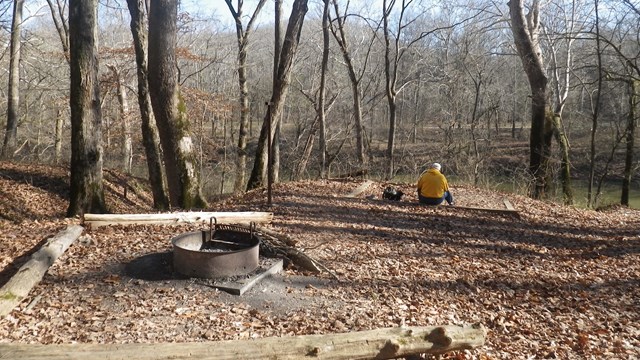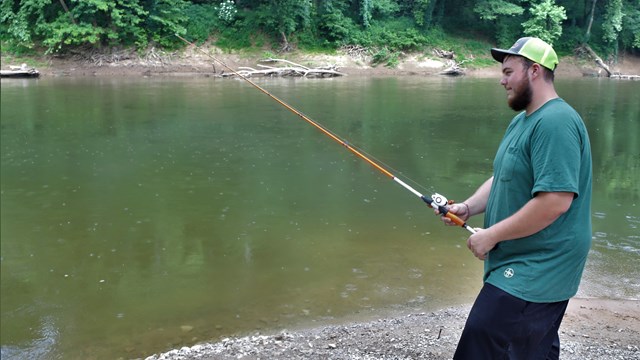
Always Wear a Life JacketPersonal flotation devices (PFDs/life jacket) are encouraged for all river users and required to be worn by children ages 12 and under at all times while on rivers inside of Mammoth Cave National Parks. It is important that your PFD is properly fitted, and US Coast Guard approved. Federal and state law requires a Type I, II, or III PFD for each person onboard a watercraft. While on The RiverDo not exceed your skill level. If you are new to canoeing and kayaking, choose a shorter trip to start out and paddle with an experienced friend.
Should an emergency arise, call 911. Be aware that cell phone service is limited inside Mammoth Cave National Park. Even if you can get a 911 call out, help can still be at least 45-90 minutes or longer away. Knowing Your Paddling Skill LevelLittle to no experience, but comfortable around water, and not afraid to swim with and recover your boat in the case of a capsize. Able to paddle and steer craft to avoid hazards including trees and rocks.
Recommended River Conditions River gauge heights from 9 to 15 feet. Warm air and river temperatures during late spring through summer, warm fall days. There are always hazards present on Green River but they are less consequential when gravel bars are shallow for re-entering boats and temperatures don’t quickly cause the onset of hypothermia. It is always preferable to paddle with more experienced paddlers in your group when starting out, as they can speed your learning of river skills and make trips safer and more fun. Some experience paddling, able to steer boat quickly and effectively to avoid any hazards even in swift current. Able to assist others in getting capsized vessels to shore. Able to confidently self-rescue without assistance in the case of a capsize. Basic understanding of reading river features such as eddies, strainers, upstream and downstream “V”s.
Recommended River Conditions River gauge heights from 9 to 18 feet, but can vary greatly for each paddler. Year round depending on current and forecasted temperatures with appropriate clothing for the conditions. It is always preferable to paddle with a group that has at least some experienced paddlers for safety and more enjoyable experiences. Extensive experience paddling on a variety of river conditions. Able to easily control boat to paddle to any point of the river without fail. Able to easily “ferry” back and forth across the river without being pushed downstream, with boat pointed either up or downstream. Proficient at “bracing” to prevent capsize. If a canoer, able to do the “j” stroke, the draw and the pry stroke, to paddle and steer without changing sides in normal paddling and able to solo paddle the canoe. Practiced at emptying and re-entering canoes in deep water. Kayakers can roll or re-enter and pump out kayaks from deep water. Proficient at “reading” river features to interpret underwater hazards. Have adequate equipment properly stowed in vessel to independently solve problems that the group could be presented with on the river, from a leak in a boat to a boat stuck around or under a tree. Trained in the use of throw ropes for rescue. Comfortable with swift-water swimming and able to swim across the river in fast current. Able to start a fire and equipped to comfortably stay the night on the riverbank in an emergency.
Recommended River Conditions Launching in the park is prohibited when the river gauge height is over 20 feet. Experienced paddlers can paddle Green River year-round in any conditions that they are properly equipped for and comfortable with. Leave it at HomeAlcohol is prohibited on the rivers inside the park. Don’t drink or use drugs – alcohol and drugs impact your judgement and coordination. Operating a vessel (boat, kayak, etc.) while under the influence is illegal. Safety Considerations Around Green River FerryAn auto ferry operates on the Green River at River Mile 197. The vessel lacks clear visibility and the ability to stop quickly. It can easily swamp a canoe or kayak. In a mishap, the risk of being pulled under the vessel by the current exists.
SwimmingSwimming in park waters is not recommended. At normal stage, the Green River flows at a relatively brisk 4.3 knots, about 5 miles per hour, which is too strong to swim against. There is no designated swimming area in the park and no lifeguards on duty.
Boating Regulations

Canoeing, Kayaking and Boating
Plan your river trip in the park. 
Backcountry and Riverside Camping
Learn more about backcountry camping in the park. 
Fishing
Fishing regulations and more. |
Last updated: February 12, 2025
